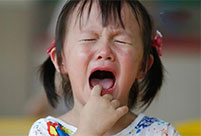

II. Women and the Economy
Equal participation in economic activities and equitable access to economic resources are the basic conditions for the well-being and development of women. While pressing forward with a strategic adjustment of its economic structure and reform and innovation of its growth model, China fully protects the economic interests of women, promoting women' s equal participation in economic development and equal access to the fruits of reform and development.
Significant progress has been made in alleviating poverty among women. During the implementation of comprehensive poverty reduction strategies, China has given overall consideration to the impact of urbanization, aging, climate change and other social and market factors on poverty among women, and strengthened efforts to address such poverty. China has implemented a program for poverty alleviation through development in rural areas, making women a key focus of attention and giving priority to poverty alleviation projects for women when all other conditions are equal, striving to improve the development capacity of women and bringing more benefits to them as a group. The number of impoverished women has dropped by an enormous margin, and the severity of poverty of women has been continuously alleviated. In the 592 poorest counties which are made the main targets of national poverty alleviation and development work, the poverty rate of the female population decreased from 20.3 percent in 2005 to 9.8 percent in 2010. The state has established a new-model social relief system, increasing efforts to protect impoverished women. In 2014, the numbers of women covered by subsistence allowances for urban and rural residents were 7.92 million and 18.26 million respectively, increasing by 2 million and 15.91 million, as compared to 2006. The state has actively implemented a number of public welfare and charity programs for impoverished mothers, such as the program of relief for mothers suffering from breast cancer and cervical cancer, the comfortable housing project for impoverished rural single mothers, and the mother health express program, bringing help to sick women, poor single mothers and various other groups of mothers in need.
The state ensures equal employment right for women. Employment has a vital bearing on people's quality of life. The state has promulgated and improved laws and regulations to promote fair employment and eliminate gender discrimination in employment. The Employment Promotion Law of the People' s Republic of China has a chapter specially dealing with fair employment, emphasizing gender equality in employment right. The Labor Contract Law of the People' s Republic of China has clear provisions under which businesses are required to create collective contracts for protecting female workers' rights and interests, providing a legal basis for protecting the legitimate rights and interests of female workers. To create favorable conditions for women' s employment and career development, the state has also developed, amended and implemented the Special Regulations on Labor Protection of Female Employees, along with policies that enable women in positions as middle-ranking officials, senior professionals and technicians at state organs and public institutions to retire at the same age as their male counterparts, and policies to facilitate the growth of female scientists and promote equal employment opportunities for female college graduates.
The state helps women who are seeking employment and starting businesses. The state has introduced supportive policies and measures to address the difficulties of women in seeking employment and starting businesses. To engage women in employment and entrepreneurship, the state has introduced the small-sum guaranteed loan with financial discount. Since 2009, a total of 222.06 billion yuan has been issued in small discount loans to women, helping millions of women with their new businesses and careers. The state vigorously promotes the development of housekeeping services in urban areas and handicrafts, such as weaving and knitting, in rural areas, in order that women in cities and countryside can find employment locally and close to their homes, and also to promote employment transfer. It supports female college graduates in seeking employment and starting businesses, providing training in employment, guidance in starting businesses and internship opportunities, and it has implemented the Sunshine Project, improving the quality and skills of the rural female workforce and creating conditions to promote the transfer of rural female workforce to non-agricultural sectors and urban areas. There are now more than 200,000 training schools for women nationwide, providing training sessions to a total of nearly 200 million women in new agricultural technologies and new crop species. A total of 1.5 million women have obtained titles and qualifications as agricultural technicians, and 53,000 women' s professional cooperatives have been founded. Following the launch of an employment promotion project for the disabled in urban areas in 2011, about 100,000 disabled women have joined the workforce each year.
The state improves the employment structure for women. In 2013, the total number of women employed nationwide was 346.4 million, accounting for 45 percent of the total employed population. The latest survey of the social status of Chinese women shows that women in secondary and tertiary industries grew by 25 percentage points in comparison with 10 years ago, and that female heads of various departments, professional and technical personnel, and clerical and related personnel increased by 13 percentage points. In 2013, the number of middle-ranking and senior female professional and technical personnel reached 6.61 million, or 44.1 percent of the total in this category, an increase of 9 percentage points from that of 2000. The number of female entrepreneurs keeps growing, now accounting for one quarter of the total number of entrepreneurs in China. The government has initiated an action plan to promote entrepreneurship and innovation among women, encouraging women to seek employment in emerging industries. About 55 percent of new Internet businesses are being founded by women.
The state protects the rights and interests of rural women in relation to land. China is a large agricultural country, and women living in rural areas account for about 70 percent of the total agricultural labor force. While forging ahead with deeper all-round reform and promoting village-level self-government in rural areas, the state has implemented and improved laws and policies on protecting the land rights of women in rural areas, established various systems for managing rural collective funds, assets and resources, corrected any village regulations and folk conventions for villagers that are in conflict with statutory regulations and the principle of gender equality, so as to ensure that women in rural areas enjoy equal rights of land contract and management, use of homesteads and distribution of collective income. In the verification, registration and certification of land contract and management rights, it is clearly ruled that women' s rights and interests in relation to land must be given expression to in the registration book and land right certificate, so that women in rural areas are ensured access to the resources necessary for survival and development at source.
The state improves the level of social security for women. The Social Insurance Law of the People' s Republic of China has a separate chapter for maternity insurance, clearly stipulating that women equally enjoy social security rights. In the Program for the Development of Chinese Women (2011-2020), a section titled "Women and Social Security" was added, defining the main goals, policies, and measures to enable women to enjoy equal access to social insurance, relief, welfare and assistance. The number of women participating in old-age insurance, medical insurance, unemployment insurance, industrial injury insurance, and maternity insurance keeps rising. In 2013, the numbers of women covered by old-age insurance and medical insurance for urban workers reached 146.12 million and 126.57 million, growing by 67.43 million and 72.82 million as compared to the figures in 2005, and the number of women participating in maternity insurance reached 71.17 million, an increase of 48.44 million as compared with 2005. In April 2012, the Special Regulations on Labor Protection for Female Employees was promulgated and put into effect, extending statutory maternity leave from 90 days to 98 days and increasing the level of maternity protection for women.
 |  |
 Construction of HK-Zhuhai-Macao Bridge enters final stage
Construction of HK-Zhuhai-Macao Bridge enters final stage Model of heavy-lift copter makes debuts at Tianjin expo
Model of heavy-lift copter makes debuts at Tianjin expo Art photos of Chinese beauty in Han Chinese clothing
Art photos of Chinese beauty in Han Chinese clothing Stunning photos of air show in China’s V-Day parade
Stunning photos of air show in China’s V-Day parade Models change clothes on street in Hangzhou
Models change clothes on street in Hangzhou Charming Chinese female soldiers
Charming Chinese female soldiers Beauty vs. muscular man
Beauty vs. muscular man World's passenger plane giants convene in Beijing aviation expo
World's passenger plane giants convene in Beijing aviation expo First day in kindergarten
First day in kindergarten Jungle drills
Jungle drills Luxury parenting
Luxury parenting Potential roots of disaster lie in Abe’s bills
Potential roots of disaster lie in Abe’s bills Prison officials help criminal sell drugs from behind bars
Prison officials help criminal sell drugs from behind barsDay|Week